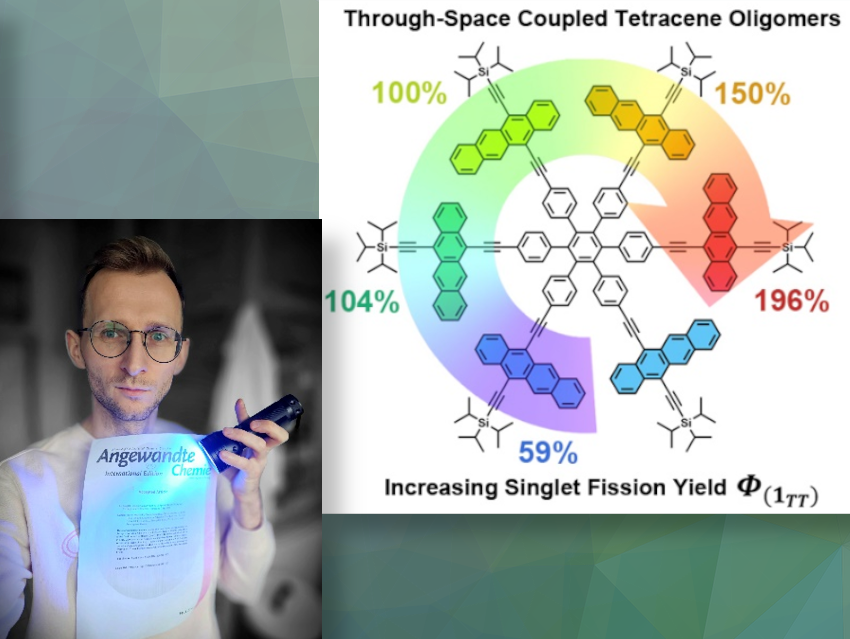Singlet fission (SF) holds great promise for current photovoltaic technologies, where tetracenes with their relatively high triplet energies play an important role for application in silicon-based solar cells. However, SF efficiencies in tetracene dimers are low due to the unfavorable energetics of their singlet and triplet energy levels.
Maciej Majdecki, Polish Academy of Sciences, Warsaw, and colleagues designed and prepared a novel molecular system based on a hexaphenylbenzene core decorated with two to six tetracene chromophores. The spatial arrangement of tetracene units, induced by steric hindrance in the central part, dictates through-space coupling, making it a versatile multichromophore model system.
What did you do? Can you please summarize the research of the article?
Our research revolves around the design, synthesis, and characterization of hexaphenylbenzene-based oligomers featuring two to six through-space-coupled tetracene units. Our main goal was to investigate the impact of an increased number of chromophores on the efficiency of singlet fission, with a specific emphasis on entropic effects.
What is the main significance of your results? What are your key findings?
In through-space-coupled systems, we have established, for the first time, a direct correlation between the number of tetracene units and the yield of singlet fission. We observed a remarkable enhancement in singlet fission yield, rising from 59% in dimers to an unprecedented 196% in hexamers, thus indicating a substantial entropic contribution to the process. Our discoveries not only advance the fundamental comprehension of singlet fission processes but also contribute to the formulation of design principles for highly efficient singlet fission materials.
What is new and cool about it?
We have devised an elegant and versatile divergent synthesis for hexaphenylbenzene-tetracene oligomers, encompassing 2-6 adjacent units. This synthetic strategy not only provides a platform for exploring through-space interactions among diverse moieties but also opens up new avenues for broader applications in the study of molecular assemblies.
Why are you doing this?
The substantial improvements in singlet fission efficiency observed in bulk tetracene films, as opposed to tetracene dimers in solution, have traditionally been ascribed to delocalization effects. In our study, we systematically investigated this phenomenon by incrementally increasing the number of coupled chromophores in a rational and controllable manner. While earlier experimental insights into singlet fission dynamics were provided by linear assemblies of chromophores coupled through-bond, our study advances this understanding by introducing systems that are coupled through space. This structural arrangement aligns more closely with solid-state film environments, enhancing the relevance of our findings for the application of singlet fission in real-world devices.
What specific applications do you envision? What is the longer-term vision for your research?
In the face of the ongoing global energy crisis, singlet fission has paramount significance as it presents a promising avenue to alleviate thermalization energy losses and enhance the efficiency of solar cell technologies. Tackling this challenge requires the exploration of novel strategies, with harnessing the SF process standing out as a pivotal avenue. To surpass the Shockley-Queisser limit, representing the maximum theoretical efficiency of single-junction solar cells (33%), the application of SF requires the use of materials with triplet energy levels surpassing the bandgap of common solar cells.
What part of your work was the most challenging? Why?
The most challenging task I faced was synthesizing the final products with exceptionally high analytical purity, needed for transient absorption spectroscopy measurements. An essential aspect was identifying the appropriate reagent for the reductive aromatization process after isolating the product from the multi-Sonogashira coupling reaction mixture. The breakthrough occurred when I discovered the effectiveness of the often-overlooked reagent P2I4, enabling an incredibly swift synthesis with almost quantitative yields. I verified this discovery by testing it on additional examples, consistently confirming its effectiveness.
Looking ahead, what future research directions or projects would you like to pursue?
I am passionate about advancing the field of spintronics and synthesizing durable luminescent radicals. This area constitutes a fascinating research field where I plan to combine the electronic and magnetic properties of organic materials. My research will focus on exploring the potential of organic molecules, leveraging their unique features such as easy chemical modifiability and structural flexibility. Exploring this area allows the development of advanced spintronic components, simultaneously utilizing the unique luminescent properties of organic radicals. This combination opens up new possibilities for magnetic diodes, spin memory, and other advanced technologies, bridging the worlds of electronics, magnetism, and optics.
Thank you for the interview.
The paper they talked about
- Singlet Fission in a New Series of Systematically Designed Through-space Coupled Tetracene Oligomers,
Maciej Majdecki, Chao-Hsien Hsu, Chih-Hsing Wang, Emily Hsue-Chi Shi, Magdalena Zakrocka, Yu-
Chen Wei, Bo-Han Chen, Chih-Hsuan Lu, Shang-Da Yang, Pi-Tai Chou, Przemysław Gaweł,
Angew. Chem. Int. Ed. 2024.
https://doi.org/10.1002/anie.202401103

Dr. Maciej Majdecki is a Postdoc at the Institute of Organic Chemistry at the Polish Academy of Sciences, Warsaw where he is part of Dr. Przemysław Gaweł’s research group.
Learn more about his passion and experience on social media, where he shares the wonders of chemistry through fascinating photos and videos produced daily in the lab:





